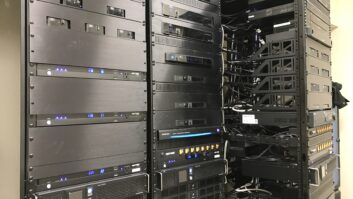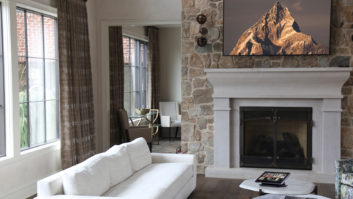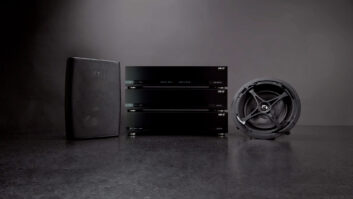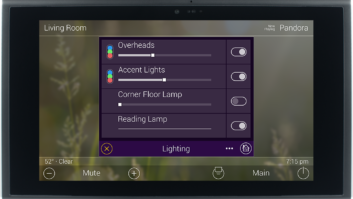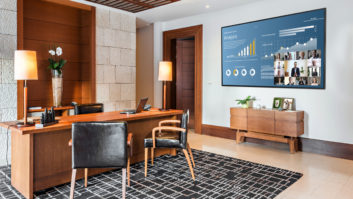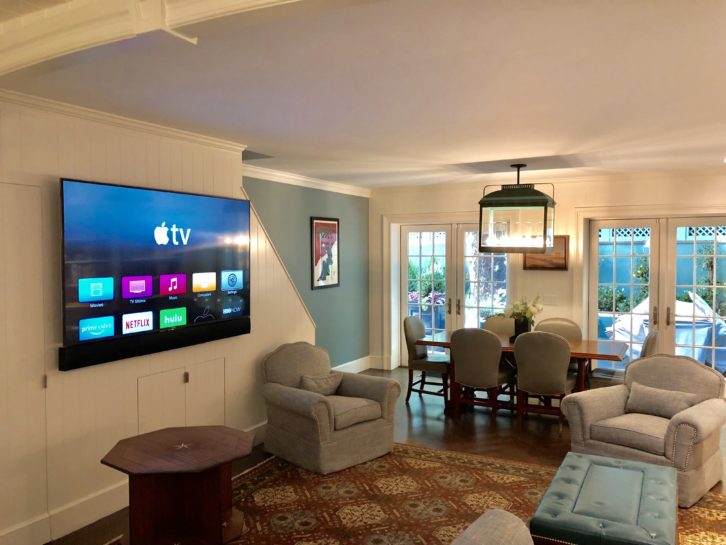
Remote Management Services (RMS) are where it’s at, so to speak.
As a fee-based service that eliminates the necessity for a truck roll, it’s an opportunity. It can also present a challenge in fulfilling customer expectations, so AV integrators have developed various approaches to present RMS to customers.

“We include RMS for all of our installations,” says Eli Weinkle, NXT AV CEO. “We elaborate about how we’ll remotely manage both their network and power. It’s in our core DNA to manage the network and power conditions in any installation site, providing the service and experience our customers expect, to prevent headaches, and to protect our reputation. We take a hands-on approach, and with more IP-based devices these days, remote diagnostics and monitoring are more important than ever.”
At Mattera Design, an RTI dealer, RMS is offered as its Maintenance/Care package for any size system from a simple media room to whole-house integration, says owner Joe Mattera. “We give customers a very detailed proposal of all the included and excluded services. It is very important to have it written down on paper and approved so there will never be any miscommunication of what is expected.”
At a rate of 33 percent of projects (and growing) signing onto RMS, the goal is to make end-users feel comfortable and confident that the company will be there for them no matter what. “Some clients are hesitant at first,” says Mattera. “They assume that they paid good money and ‘things should just work.’ We explain that with today’s ever-growing technology and heavy dependence on network devices, there is constant change with software/firmware updates from manufacturers. By having the ability to remotely manage client systems we can seamlessly monitor, manage, and reset devices, etc. to keep their systems running smoothly, as well as troubleshoot any other issues that may happen due to outside elements.”
RMS has been on the NXT AV menu for a long time and is evolving, Weinkle says. “We use SurgeX enVision diagnostics tool combined with OvrC from SnapAV for most of our projects. SurgeX has helped us evolve our power protection game, where we’re aiming to regularly deploy enVision in all of our installations. In the past, we’ve used enVision for special cases in projects where we’ve tried to troubleshoot and there was a gremlin causing problems in the system that we couldn’t find.”

Early expectations have to be set from the beginning, suggests Luxul dealer, Joe Whitaker, president, The Thoughtful Home. “The best way to do this is to state that things that will be resolved remotely will be at a discounted rate due to no truck roll or onsite work needing to be done,” he says. “While the advantage to the client and integrator is obvious, it has to be made clear up front that just because a truck doesn’t have to be rolled, work is still charged for.”
RMS come in many different types and from various manufacturers, so choosing is about preference, he adds. “Having said that, 100 percent of our clients have a ‘network type’ RMS and a large percentage have power RMS as well.”
In a constantly connected world, explaining that RMS allows technicians to have 24/7 alerts and management from anywhere is key. “The best example I can give is when the company has its annual closure for CEDIA Expo,” Whitaker says. “This is a mandatory closure in our company. And whether any of us are on the show floor, at an event, or in a class, we get an alert when something is amiss and are immediately able to assess and address the issue.”
Invite Customers In
At Design Entertainment, the initial approach is to invite customers to see the design center, says co-owner, Ben Remer. “There, we can show them all of the products that have built in OvrC and explain to them that any products without OvrC (i.e., modems and TV) can still be managed with WattBox power products. That leads into showing the customer our internal OvrC app and how we manage with that, while also showing them OvrC Home, which they can manage on their own.”
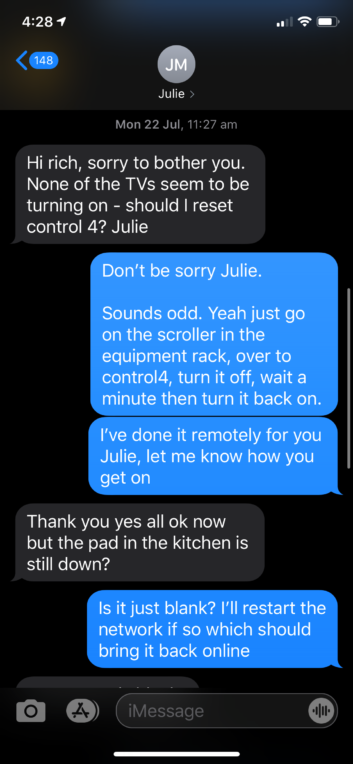
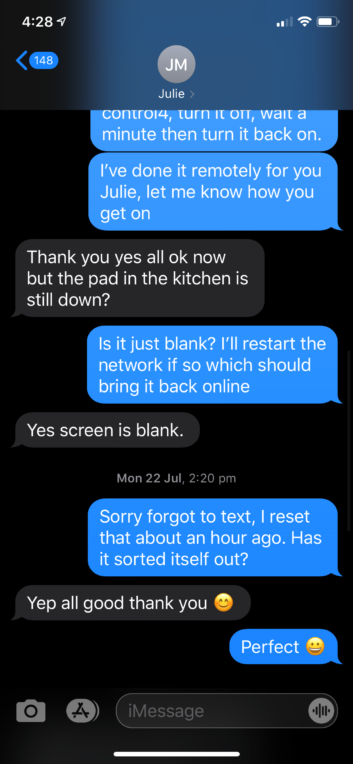
This way, customer expectations are set upfront. “We explain that if they choose not to proceed with RMS, they will most likely incur service call/truck roll charges for an event that could be simply rebooted with RMS,” he adds. “A very high percentage of customers understand that cable modems, media streamers, and smart televisions need to be rebooted quite often. The home network and smart RMS surge protection are the backbones to our systems. Customers usually understand that if the internet is down or not strong enough, or if a piece of equipment is locked up, no part of the system will function properly.”
At Art of Smart, RMS is not an option, says Rich Heppell, director. “If you want a system done by us, then you will have full Pakedge managed networking, and IP PDU (power distribution unit) and UPS (uninterruptible power supply). A lot of our new clients will request a Pakedge network and remote monitoring as a direct result of seeing how we handle issues, and then post about it on our Instagram story. They are aware that their networks will be monitored and we will proactively fix issues in the system.”
The company builds 12 months of remote monitoring into the cost of a job, giving the clients the benefits of having their systems remotely maintained, he adds. “We find around 90 percent of people are choosing to continue this after the free 12-month period. We explain the benefits of RMS to those who don’t know about it already. Ultimately, the additional cost can cause us to lose some jobs; however, we see those as headaches with unnecessary truck rolls avoided.”
Stuart Burgess, managing director, Just Add Popcorn, finds that customer experience with remote management is limited, so benefits are explained at the sales stage. “We teach our customers how using equipment that supports remote management can benefit them, even if they do not use it straightaway. We are asked by clients how often we need to visit the house to do updates, which is an opportunity to explain the benefits for remote management. If the customer goes for equipment with remote management at the sales stage, we normally give them six months of free support so we can show off the benefits; then we migrate them to a service plan after the free trial. It’s also a good way to seal a sale by offering the support for free for an initial time.”
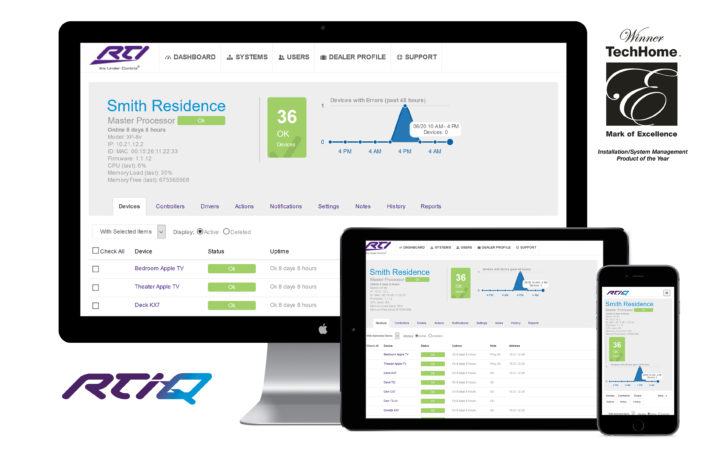
Latest and Greatest
The Thoughtful Home’s latest and greatest install of RMS is currently underway, Whitaker says, featuring a fully tested RMS for the network down to managed-per-port shutdown to power cycle PoE devices, full power per plug/device control to be able to remotely reboot any individual device on the fly, and remotely managed and monitored UPS to not only keep the system up, but also to watch and log power dips and spikes.
NXT AV monitors power and network conditions along with other critical systems using OvrC and SurgeX enVision, Weinkle says. “The two-part remote approach helps us build our foundation to manage all of our clients’ systems without having to roll trucks or schedule time to visit houses. We’re constantly evolving our deployments, and OvrC helps us do a better job. We also use OvrC to remotely log into the system to see system issues that we can pinpoint with the power data from enVision. We have a project where we ran into system issues, and we were able to remotely discover the problem. Remote visibility into a project with diagnostics and real-time alerts help us target and adjust the problem, and identify the steps to prevent it from happening.
“In one scenario, a customer’s products like amplifiers and set-top boxes were dying out,” Weinkle adds. “With the SurgeX enVision, we were able to get to the root of the problem: under voltage that was happening only between 11 PM and 3 AM. Under voltages can be hidden killers, as detrimental — if not worse — than lightning strikes. Being based in California, most of our customers aren’t aware of power problems because they don’t have frequent storms and lightning, but the SurgeX enVision helps us show the logs of the power problems and do corrective actions to prevent havoc in the system.”
The latest and greatest RMS system is definitely OvrC, Remer says. “Especially the WattBox Wattlet, WatBox IP vertical power strips, and OvrC Pro. A Wattlet can be installed behind every TV in a home. The vertical strip allows for independent reboots of cable boxes, streamers, and automation products. OvrC Pro allows us to remote access certain products GUI interfaces and diagnose/fix third-party products.
Related: Rethinking Service
“We sell and install our systems all over the world,” he adds. “We are comfortable doing so because we utilize OvrC. We have a customer that lives in Ohio but also has a vacation home on Long Island, Bahamas. Needless to say, the power grid and internet are not super reliable. With OvrC, we can keep his system up and running from Ohio so that our customer can still view his cameras, monitor his thermostat, and even water his lawn when he isn’t at the Bahamas house.”
One of Mattera Design’s current total integration projects is for a six-story combined double townhouse with more than 14 integrated rooms. “It has total AV integration along with a professional network system. We are able to monitor, test, and troubleshoot almost every device in the system on the fly whether it be a simple device reboot or for sending macro commands to test and reload a scene or command.”
Another Mattera client was hosting an extremely important benefit at his residence and experienced a power outage, losing music and Wi-Fi right at a key presentation. “The client sent us a high-level email and we were able to log on right on from a phone, reboot the entire system, and send a Start-Up scene command. Everything was back online in a matter of minutes. They were extremely grateful and happy we talked them into our Remote Maintenance/Care package.”
Art of Smart currently uses only Pakedge and BakPak. “However, we’re looking forward to seeing how this evolves with SnapAV’s remote monitoring solutions after the merger,” Heppell says. “We initially cost all items in the rack to be on IP-controlled sockets, but can scale this back to suit budgets, so that if a client is having issues with a device, we can remotely reboot it without having to actually go on-site. The systems also have the ability to tell us when things have fallen offline on the network and give us a chance to proactively fix something before the clients even notice.”
RMS issues typically involve logging in to power cycle PoE devices such as CCTV when the client is away and cannot see the feed, he adds. “We’ll also set alarms so we get notified if a situation changes. We have one client who gets a notification if his wine cellar’s temperature increases to a point where it might affect his collection.”
Related: Automate Your RMR Business!
From the Manufacturers
“Part of our training curriculum teaches installers how to sell these types of services to a client,” says Vincent Bova, director of dealer experience, RTI. “RTIQ is a free intelligent monitoring service that allows the installer and his employees to monitor several key diagnostic indicators for RTI and third-party equipment. The installer can also create custom actions that he can trigger from a remote location to heal, troubleshoot, or reset a system.”
If there is resistance in suggesting RMS to a client, offer the client a version of the service that is free of charge, he adds. “Set up monitoring for key safety indicators like security zones, door locks, garage doors, and other indicators. Provide the client with a report on the next service call, which shows how some of this monitoring could have prevented problems and provided alerts, and the client will realize the tangible value of RMS.”
As in any successful business, the integrator needs to set the expectations early and communicate clearly and often to avoid the nightmare, notes Mike Grubb, VP of marketing, Legrand AV, Residential Solutions. “This can lead to a great relationship and customer experience with their connected systems.
“The more open the line of communication between integrator and client, the better chance expectations will be met,” he adds. “The best way to accomplish this is to follow a predictable and repeatable process. When the integrator is in the discovery stage of the project, he or she should engage in as many questions as possible to understand the needs and expectations of the system as well as the final experience the client desires; documenting this information is essential. As the integrator understands the desires of the client, he or she can build them into a design proposal and deliver a concise solution that exceeds all expectations at the proposal review meeting.”
The proposal should include serviceability of the system as a functionality of the RMS, Grubb says. “The integrator should clearly communicate the value of the RMS and why it’s being included in the proposal to the client. The hours of serviceability (integrator service access to the system) should be identified, communicated, and documented as well. The Luxul feature-rich platform is pretty self-explanatory, and once integrators hear about what it can do, the light bulb goes off and they simply get it. They see how this will save time, money, truck rolls, and how it can create a better experience for their customers.”
And as in every other service, RMS needs to be carefully detailed in contracts, Bova says. “A frequently asked question section is helpful, and customers can understand how the contract protects them and the installation firm. While RMS business models are on the rise, I think a relatively low percentage of installation firms deploy them, particularly smaller companies. As new products and services are released promising 24/7 monitoring components, it is becoming increasingly difficult for the average AV company to ignore RMS.”
Whitaker likes to joke about a customer issue that occurred with a favorite client as he, Whitaker, was boarding a plane. “I saw a ‘network down’ alert and before I could even check on it, the client called me. The ISP was there and had messed up some stuff. Before my plane took off I was able to get in, resolve the issue, and all was good. I had more than ten texts by the time I landed telling me how awesome we were. This is why RMS is so important.”

